Blender Dental 4.0 – Revolutionary Free Dental CAD Design Software
Table of Contents
Introduction to Blender Dental 4.0
Why Use Blender for Dental CAD?
Key Features of Blender Dental 4.0
Model Designer
Crown & Bridge Tool
Virtual Articulator
System Requirements & Installation Guide
Workflow Steps: Dental Modeling
Conclusion
FAQs
Introduction to Blender Dental 4.0

Blender Dental 4.0 is a revolutionary update to the open-source 3D software Blender, now specially optimized for dental CAD design. With this version, dentists and lab technicians can design crowns, bridges, and full dental models for free—no expensive licenses required.
Why Use Blender for Dental CAD?

Blender Dental 4.0 offers:
Cost-effective (100% free)
Regular updates and plugin support
3D dental design in high precision
Compatible with STL, PLY, and OBJ formats
Community support and tutorials available
This software is a perfect solution for labs, clinics, and freelancers looking for reliable dental CAD tools.
Key Features of Blender Dental 4.0
🔹 Model Designer
Use tools to scan, clean, and edit jaw models or intraoral scans.
🔹 Crown & Bridge Tool
Design and shape crowns or bridges with automated margin line detection and contact checks.
🔹 Virtual Articulator

Simulate occlusion and jaw movements using integrated articulation systems.
Advanced Tools Include:
Gingiva sculpting
Bite adjustment
Wax-up modeling
Implant placement simulation
System Requirements & Installation Guide
Minimum System Requirements:
Processor: Intel i5 / AMD Ryzen 5
RAM: 8 GB
GPU: NVIDIA GTX 1050 or higher
Disk: 2 GB of free space
Installation Steps:
Download Blender 4.0 from blender.org
Install the Dental add-on/plugin
Go to Preferences > Add-ons and enable Dental Tools
Restart Blender and access dental options from the sidebar
Workflow Steps: Dental Modeling
Step-by-Step Process:
Import STL or 3D scan data
Use mesh editing tools to clean model
Mark margin lines and segment teeth
Design crown or bridge using custom presets
Simulate articulation and occlusion
Export final design for 3D printing
Workflow Tips:
Use Top/Side/Front views for better alignment
Always adjust Z-axis orientation
Save frequently in
.blendformat for editing later
🌐 External links:
✅ Official Blender Website (DoFollow)
Download the latest Blender 4.0 release directly from the official website.✅ Blender Dental Wiki & GitHub (DoFollow)
Access Blender Dental add-ons, updates, and source code maintained by the open-source community.✅ Dental CAD 3D Printing Guide (DoFollow)
Discover how to prepare and export dental CAD files for professional 3D printing workflows.
Internal links:
🔗 Also check our Dental CAD Services for expert support in software setup, crown and bridge design, and workflow integration. (Internal Link – DoFollow)
🔗 Visit our Exocad Free Download page to explore the best Exocad versions for beginners and pros alike. (Internal Link – DoFollow)
🔗 Explore our Dental CAD Tutorials section to master crown design, margin marking, articulation, and more. (Internal Link – DoFollow)
🔗 Need support? Head over to our Contact Page to get in touch with our team for custom solutions. (Internal Link – DoFollow)
Conclusion
Blender Dental 4.0 empowers dental professionals with a free, open-source CAD solution that rivals expensive commercial software. Whether you’re designing crowns, bridges, or full dental models, it offers precise tools for every step of the workflow. With regular updates, community support, and compatibility with major file formats, it’s ideal for clinics, labs, and freelancers looking to digitize their practice. Embrace the future of digital dentistry without the high costs—Blender Dental 4.0 makes professional design accessible to all.
FAQs
🔸 Is Blender Dental 4.0 completely free?
Yes, it’s open-source and free for both personal and commercial use.
🔸 Can I use it for professional dental work?
Yes, many labs and technicians already use Blender Dental for crown, bridge, and implant design.
🔸 Is it compatible with 3D printers?
Absolutely. You can export models in STL format for any compatible 3D printer.
🔸 Does it support DICOM files?
Not directly, but you can use external tools to convert DICOM to STL before importing.






